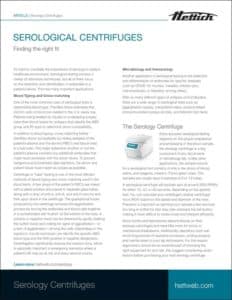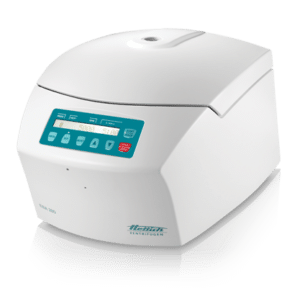File size: 163.7 kb
Serological Centrifuges
Finding the right fit
It’s hard to overstate the importance of serology in today’s healthcare environment. Serological testing involves a variety of laboratory techniques, but all of them focus on the detection and identification of antibodies in a patient’s blood. This has many important applications.
Blood Typing and Cross-matching
One of the most common uses of serological tests is determining blood type. The Red Cross estimates that 29,000 units of blood are needed in the U.S. every day. Patients being treated for injuries or undergoing surgery need their blood tested for antigens that identify the ABO group and Rh type to determine donor compatibility. In addition to blood typing, cross-matching further identifies donor compatibility by mixing samples of the patient’s plasma and the donor’s RBC’s (red blood cells) in a test tube. This helps determine whether or not the patient’s plasma contains any additional antibodies that might react adversely with the donor blood. To prevent dangerous and potentially fatal reactions, the donor and patient blood must match as closely as possible. Centrifuge or “tube” testing is one of the most efficient methods of blood-typing and cross-matching used in the blood bank. A few drops of the patient’s RBC’s are mixed with a saline solution and placed in separate glass tubes along with a drop of anti-A, anti-B, and anti-D serums and then spun down in the centrifuge. The gravitational forces produced by the centrifuge enhance the agglutination process by forcing the antibodies and blood cells together in a concentrated cell “button” at the bottom of the tube. A positive or negative result can be observed by gently shaking the button loose and looking for signs of agglutination—or a lack of agglutination—among the cells. Depending on the reactions, the lab technician can identify the specific ABO blood type and the RhD positive or negative designation. Centrifugation significantly reduces the reaction time, which is especially important in emergency scenarios where a patient’s life may be at risk and every second counts.
Microbiology and Immunology
Another application of serological testing is the detection and differentiation of antibodies for specific diseases such as COVID 19, mumps, measles, chicken pox, mononucleosis, or hepatitis, among others. With so many different types of antigens and antibodies, there are a wide range of serological tests such as agglutination assays, precipitation tests, enzyme-linked immuΩnosorbent assays (ELISA), and Western blot tests.
The Serology Centrifuge
Since accurate serological testing depends on the proper preparation and processing of the blood sample, the serology centrifuge is a key component of any blood bank or hematology lab. Unlike other applications, the sample volume for a serological test consists of only a few drops of blood, saline, and reagents, mixed in 75mm glass tubes. The samples are usually spun in batches of 6 or 12 tubes. A serological centrifuge will typically spin at around 3500 RPM’s for either 15, 30, or 60 seconds, depending on the specific test. You can calculate your centrifuge’s relative centrifugal force (RCF) based on the speed and diameter of the rotor. Precision is important as spinning your sample a few seconds too long or a little too fast may over-compact the cell button, making it more difficult to shake loose and interpret efficiently. Blood banks and laboratories depend heavily on their serology centrifuges and have little room for errors or mechanical breakdowns. Additionally, laboratory work can entail long periods of repetitive processes, adding physical and mental strain to your lab technicians. For this reason, ergonomics should be an essential part of choosing the right equipment for your lab. We suggest considering seven factors before purchasing your next serology centrifuge.
Swing-out Rotor
When shopping for a centrifuge, we recommend choosing one with a swing-out rotor option instead of a fixed angle. Loading a batch of uncapped glass tubes vertically into the swing-out tube holders is much easier than into a fixed-angle rotor, and the extra seconds you’ll save on each batch can add up by the end of a busy day. Also, many lab technicians have found that a 60-degree swing-out rotor forms the cell button at a more optimal position inside the tube, making it easier to shake loose than those formed with a 45 or 90-degree rotor.
Footprint
Space is at a premium in most laboratories, particularly on your benchtop. It’s important to measure and evaluate the available area you have when choosing a centrifuge. Make sure its overall size and footprint fit comfortably in your workspace.
Accessibility
Lab technicians can spend sustained periods of time maintaining a posture or position that can cause strain to the neck, back, arms and shoulders. The design of a centrifuge can force your lab techs to stretch or strain awkwardly to load or remove the tubes. Additionally, some lids may require more effort to close and access. All these factors can contribute to undue strain or even injury over the long term. So it is important to choose a centrifuge designed with a low profile for accessibility and an easy open-and-close lid.
Display Visibility
The size, brightness, and positioning of the display screen and control panel are also essential factors to consider when purchasing a centrifuge. Lab technicians often struggle to read the display, so be sure to choose a centrifuge with a front-facing screen that is large enough and bright enough to be easily visible. This can also help them avoid constant bending and leaning in to read or access the controls. Also, choose a centrifuge that uses both audio and visual indicators to alert you when the spin cycle is complete.
Controls
Along with enhanced visibility, the control panel design should facilitate ease of use and flexibility to accommodate a wide range of serological applications. Accurate blood typing and cross-matching require a very specific combination of relative centrifugal force (RCF) and spin-time, so you will want a unit that is easy to program and access your most common settings. The Hettich EBA 280 S allows you to store up to 10 user-defined programs.
Noise Level
Labs are often noisy places, and centrifuges can add to the volume. High noise levels make it harder for your technicians to focus on their tasks or communicate easily. A quiet-running centrifuge will help improve the overall working environment in your lab. One factor affecting centrifuge noise is the direction of airflow inside the chamber. A well-engineered centrifuge will address this feature and make for a much quieter operation.
Warranty
Finally, an often overlooked centrifuge feature is the warranty. While not a physical part of the equipment design, a good warranty does add value to your purchase and should be considered when making your decision. Be sure to ask your sales representative for details about their company’s standard warranty. A typical manufacturer warranty will run for one or two years. Hettich offers a standard five-year warranty on all of their centrifuges.
Choosing the right laboratory equipment partner
Purchasing a serology centrifuge is more than just buying a piece of equipment, you’re investing in a trusted laboratory partner. Be sure to choose a manufacturer known for the quality of their engineering and proven product expertise. As with all of your laboratory equipment, you should be looking for a centrifuge you can depend on to provide reliable and consistent results over the long term. Review the design specs, component quality, and the variety of options and accessories the manufacturer offers. Do they have product offerings for all your needs? A well-engineered centrifuge is worth the extra investment and can easily save you money in maintenance and repair costs over time.



